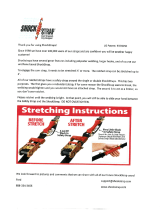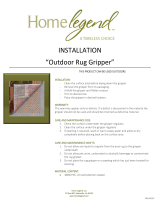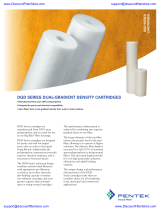
08/2010 Rev. 2/7/2018 DGS-A, MANUAL
Copyright 2018 Vestil Manufacturing Corp. Page 1 of 8
DGS-A, DGD-A, & DGS-AG Fork-Mounted Drum Lifters
Use and Maintenance Manual
DGS-A DGD-A
DGS-AG
Receiving instructions:
After delivery, remove the packaging from the product. Inspect the product closely to determine whether
it sustained damage during transport. If damage is discovered, record a complete description of it on the
bill of lading. If the product is undamaged, discard the packaging.
NOTE:
The end-user is solely responsible for confirming that product design, installation, use, and maintenance
comply with laws, regulations, codes, and mandatory standards applied where the product is used.
Table of Contents
Signal Words…………………………............................................................................................................... 2
Hazards of Improper Use………….................................................................................................................. 2
DGS-A Parts Diagram, Bill of Materials, and Specifications……………………………………………………… 3
DGS-AG Parts Diagram, Bill of Materials, and Specifications……………………………………………………. 4
DGD-A Parts Diagram, Bill of Materials, and Specifications……………………………………………………… 5
Using the Drum Carrier………………………………………...……………………………………………………... 6
Inspections & Maintenance…….………………………………………………………………………………… 6 – 7
Labeling Diagram……………………………………………………………………………………………………… 7
Limited Warranty………………………………………………………………………………………………………. 8
Vestil Manufacturing Corp.
2999 North Wayne Street, P.O. Box 507, Angola, IN 46703
Telephone: (260) 665-7586 -or- Toll Free (800) 348-0868
Fax: (260) 665-1339

08/2010 Rev. 2/7/2018 DGS-A, MANUAL
Copyright 2018 Vestil Manufacturing Corp. Page 2 of 8
Signal Words:
This manual uses SIGNAL WORDS to direct the reader’s attention to statements about uses of the
product that could result in personal injury or property damage. Each signal word correlates with a specific
hazard level.
Identifies a hazardous situation which, if not avoided, WILL result in DEATH or
SERIOUS INJURY. Use of this signal word is limited to the most extreme
situations.
Identifies a hazardous situation which, if not avoided, COULD result in DEATH or
SERIOUS INJURY.
Identifies practices likely to result in product/property damage, such as operation that
might damage the drum lifter.
Hazards of Improper Use:
Vestil strives to identify all hazards that could arise while using its products. However, material handling
is dangerous. No manual can address every conceivable risk. Ultimately, the most effective way to avoid
injury is to apply sound judgment whenever using this device.
Improper or careless use of this product might result in serious personal injury.
DO NOT exceed the maximum rated load of your lifter (see Label 287 on product; “Labeling diagram” on
p. 7; “Specifications” on pp. 3-5).
Inspect the lifter before each use—before mounting it to your fork lift. DO NOT use this drum lifter unless
it is in normal condition! “Normal condition” is defined in “Inspections & Maintenance” on p. 6-7. DO NOT
use the drum lifter until it is restore to normal condition.
Inspect the drum before using the carrier to transport it. Make sure that the drum (particularly the rim
and rolling hoops) is in good condition. DO NOT attempt to lift or transport a damaged drum with the
carrier.
Stay clear of the drum and carrier! No part of your body should ever be beneath any part of the lifter or
drum.
ONLY use this device to move the type of drum(s) that is/are compatible with your carrier model (steel,
plastic, and fiber). Compatibility is indicated in the “Specifications” information on pages 3-5.
When transporting a drum, only raise it a few inches above the ground.
Transport drums slowly. Avoid rough terrain when transporting drums. Jostling might disrupt the grasp
on the rim.
Avoid sudden stops when transporting drums. Brake gradually. Sudden stops could cause the carrier to
slide on the forks and could damage the safety strap, hook, and/or quick link. Turn slowly. Sharp, quick
turns could disrupt the clamp on the drum and damage the carrier.
DO NOT modify the product in any way without first obtaining written approval from Vestil. Unapproved
modifications automatically void the Limited Warranty (p. 8) and might make the carrier unsafe to use.
DO NOT use the lifter UNLESS all labels (see “Labeling diagram” on p. 7) are in place, readable, and
undamaged.
The safety strap must be used every time the unit is mounted on a fork truck. Wrap the free end of the
strap around the fork carriage; then fasten the hook to the strap or carriage without slack (strap must be
taut).

08/2010 Rev. 2/7/2018 DGS-A, MANUAL
Copyright 2018 Vestil Manufacturing Corp. Page 3 of 8
DGS-A parts diagram and bill of materials
Item
Part No. Description Qty.
1 09-514-087 Weldment, frame 1
2 40-514-016 Frame, casting, arm 2
3 40-112-001 Pin, main, clevis 2
4 15-112-014 Pin, clevis, 1” x 4
1
/
2
” 2
5 65125 Cotter pin, zinc plated,
3
/
16
” x 1
1
/
2
” 4
6 08-145-028 Restraining/safety strap 1
7a
7b
40-012-010
40-012-011
Hinge, casting, arm, right
Hinge, casting, arm, left
1
1
Specifications:
Compatible with 30gal. and 50gal. steel drums
only. Drums may be open or closed head.
Open head drums must have lids properly
and securely fastened.
Capacity = 800 lb. (363.6 kg)
Net weight = 109 lb. (49.4 kg)
Arms pivot about a horizontal axis to fold onto
the frame for storage.
Distance between fork tube centers = 19
3
/
4
”
Usable fork tube dimensions = 7
5
/
8
”W x 1
7
/
8
”H

08/2010 Rev. 2/7/2018 DGS-A, MANUAL
Copyright 2018 Vestil Manufacturing Corp. Page 4 of 8
DGS-AG parts diagram & bill of materials
Specifications:
Manual, ratcheting drum clamp mechanism
Compatible with open and closed head drums made of steel and
plastic. Open head drums must have lids properly & securely
attached.
Capacity varies with drum material:
Steel = 1,500 lb. (681.8 kg)
Plastic = 1,000 lb. (454.5 kg)
Arm spacing adjustable from 18” to 28”
Arms pivot about a horizontal axis to fold onto the frame for
storage
Distance between fork tube centers = 19
3
/
4
”
Usable fork tube dimensions = 7
5
/
8
”W x 1
7
/
8
”H
Item
Part No. Description Qty.
1 40-514-060 Weldment, frame 1
2 40-514-016 Frame, casting, arm 2
3 15-112-014 Pin, clevis, 1” x 4
1
/
2
” 2
4 65125 Cotter pin, zinc plated,
3
/
16
” x 1
1
/
2
”
6
5 40-514-059 Weldment, gripper bracket 1
6 30-001-213-001
Load binder without hooks 1
7 40-112-013 Pin, gripper guide 1
8 40-113-009 Spacer 2
9 33018 USS flat washer, zinc plated,
3
/
4
” 6
10 40-146-003 Spring, compression 2
11 40-537-007 Weldment, spring stopper 2
12 36109 Hex nut, gr. A, plain finish,
1
/
2
”-13 4
13 40-516-009 Hinge, casting, gripper, left 1
14 40-516-010 Hinge, casting, gripper, right 1
15 08-145-028 Restraining/safety strap 1
Cross support
Pawl

08/2010 Rev. 2/7/2018 DGS-A, MANUAL
Copyright 2018 Vestil Manufacturing Corp. Page 5 of 8
DGD-A parts diagram and bill of materials
Item
Part No. Description Qty.
1 09-514-085 Weldment, frame, base 1
2 40-012-012 Hinge, casting, arm 2
3 40-514-016 Frame, casting, arm 2
4 40-112-001 Pin, main, clevis 2
5 15-112-014 Pin, clevis, 1” x 4
1
/
2
” 3
6 65125 Cotter pin, zinc plated,
3
/
16
” x 1
1
/
2
” 5
7 09-514-086 Frame, weldment, middle attachment 1
8 08-145-028 Restraining/safety strap 1
Specifications:
Compatible with 30gal. and 50gal. steel drums only.
Drums may be open or closed head. Open head
drums must have lids properly and securely
fastened.
Capacity = 1,500 lb. (681.8 kg)
Arms pivot about a horizontal axis to fold onto
the frame for storage.
Distance between fork tube centers = 24”
Usable fork tube dimensions = 7
5
/
8
”W x 1
7
/
8
”H

08/2010 Rev. 2/7/2018 DGS-A, MANUAL
Copyright 2018 Vestil Manufacturing Corp. Page 6 of 8
Using the drum carrier:
Standard DGS and DGD model drum carriers are designed to be used in non-classified, general
industry locations. They should not be used to transport hazardous wastes.
Step 1: Adjust the positions of the forks on the carriage of your lift truck to match the fork tubes. Drive the
forks into the fork tubes. Mount the drum lifter on the forks of your lift truck by slowly driving forward until
the forks contact the ends of the pockets. Wrap the free end of the strap around the fork carriage. Attach
the hook either to the strap or to the carriage. There must be no slack in the strap. Slack in the strap could
allow the lifter to slide off of the forks if, for instance, you brake suddenly. The strap must not be able to
disconnect from the carriage.
Step 2: Open the arms of the carrier.
a) DGS-A & DSD-A: Raise the forks and tilt
the mast forward to spread the arms
slightly.
b) DGS-AG: Raise the forks. Adjust the
mast tilt to make the gripper arms parallel to
the floor. The left and right gripper hinges
(see items 13 and 14 on p. 4) must not
touch the cross support. Adjust mast tilt, if
necessary. Move the ratchet handle back-
and-forth a few times. Grasp one of the
receivers during the back stroke to allow the
handle to ratchet backwards. If the arms are
moving closer together, then press down
the top of the pawl to reverse directions.
Move the handle back-and-forth until the
arms are wide apart enough to fit around
the drum.
Step 3: Engage the drum.
a) DGS-A & DGD-A: Elevate the forks and adjust position so that the gripper arms are above the drum.
Slowly lower the forks to bring the gripper arms over the top of the drum. Continue lowering the forks. The
gripper arms will slide down the side of the drum. Position the arms below the first rolling hoop.
a) DGS-AG: Make sure that the arms are far enough apart to fit around the drum. Drive toward the drum
with the drum between the arms. Stop when the drum contacts the back of the gripper arms. Adjust the
height of the forks to bring the top sides of the arms into contact with the top rolling hoop (of the drum).
Park the fork lift. Move the handle back-and-forth to bring the gripper arms into firm contact with the side of
the drum. NOTE: Do not overtighten the arms, particularly when clamping plastic and fiber drums.
Step 4: Raise the forks.
a) DGS-A & DGD-A: Elevate the drum just a few inches above the ground. Tilt the mast back slightly.
b) DGS-AG: Elevate the forks sufficiently to raise the drum a few inches above the ground.
Step 5: Transport the drum to the necessary location. Turn slowly and brake gradually. Stopping suddenly
might cause the carrier to slide on the forks or disrupt the clamp on the drum.
Step 6: Release the drum.
a) DGS-A & DGD-A: Tilt the mast forward. Slowly lower the forks until the entire bottom drum rim rests on
the ground. Carefully back away from the drum until the gripper arms are completely free of the drum.
b) DGS-AG: Lower the forks until the entire lower drum rim rests on the ground. Reverse the pawl. Move
the handle back-and-forth the release the clamp on the drum. Grasp one of the receivers during each
backstroke.
Inspections & Maintenance:
Regular inspections and maintenance are necessary for the drum carrier to remain in normal condition.
Before using it for the first time, create a written description of the appearance of the drum grippers,
hinges, ratchet mechanisms (DGS-AG only) pins, fork pockets, the safety strap and quick link, and the
frame. Install the lifter on the forks of your forklift and lift a drum. Record your observations about how the
Rim
Wrap strap
around carriage
without slack
Quick
link
Gripper arm
contacts bottom
of top rolling hoop
Top rolling hoop

08/2010 Rev. 2/7/2018 DGS-A, MANUAL
Copyright 2018 Vestil Manufacturing Corp. Page 7 of 8
gripping mechanism engages the drum. Lower the drum and record your observations. This written record
establishes “normal condition”. When conducting future inspections compare those observations to the
written record to determine whether a component is in normal condition.
Before each use, inspect the following components. Replace any component that is not in normal
condition before returning the carrier to service.
1. Safety strap, quick link, and hook (attached to the free end of the safety chain): confirm that the quick
link is undamaged and welded securely to the frame. The hook should not be bent, stretched, cracked,
or otherwise damaged. Check the strap for cuts, tears, etc.
2. Gripper arms and hinge castings: confirm that both arms and hinge castings are not cracked or
warped. Hinge castings should rotate smoothly to allow the arms to fold onto the frame for compact
storage.
3. Labels: all labels should be readable and located as shown in “Labeling diagram” (below). If a label is
unreadable or missing, contact Vestil to order a replacement.
4. Fasteners (hardware): examine all bolts, nuts, washers, pins, and cotter pins.
5. Frame and fork tubes: confirm that each pocket is structurally sound, i.e. free of significant
rusting/corrosion. Confirm that all welds are intact. The frame should be square and rigid and free of
rust and corrosion. Remove rust with steel wool. Clean the affected area and apply touchup paint.
Remove dirt and debris.
Labeling diagram:
The drum lifter should always be labeled as shown in the diagram below. Replace any label that is
missing, damaged, or not easily readable (faded, for example).
NOTE: Labels and label locations are subject to change without notice.
A: Label 218 (on fork pocket)
B
C
B: Label 287 (on fork pocket)
A
C: Label 527

08/2010 Rev. 2/7/2018 DGS-A, MANUAL
Copyright 2018 Vestil Manufacturing Corp. Page 8 of 8
LIMITED WARRANTY
Vestil Manufacturing Corporation (“Vestil”) warrants this product to be free of defects in material and workmanship during
the warranty period. Our warranty obligation is to provide a replacement for a defective original part if the part is covered
by the warranty, after we receive a proper request from the warrantee (you) for warranty service.
Who may request service?
Only a warrantee may request service. You are a warrantee if you purchased the product from Vestil or from an
authorized distributor AND Vestil has been fully paid.
What is an “original part”?
An original part is a part used to make the product as shipped to the warrantee.
What is a “proper request”?
A request for warranty service is proper if Vestil receives: 1) a photocopy of the Customer Invoice that displays the
shipping date; AND 2) a written request for warranty service including your name and phone number. Send requests by
any of the following methods:
Mail Fax Email
2999 North Wayne Street, PO Box 507 Phone
Angola, IN 46703 (260) 665-7586
In the written request, list the parts believed to be defective and include the address where replacements should be
delivered.
What is covered under the warranty?
After Vestil receives your request for warranty service, an authorized representative will contact you to determine whether
your claim is covered by the warranty. Before providing warranty service, Vestil may require you to send the entire
product, or just the defective part or parts, to its facility in Angola, IN. The warranty covers defects in the following original
dynamic components: motors, hydraulic pumps, electronic controllers, switches and cylinders. It also covers defects in
original parts that wear under normal usage conditions (“wearing parts”), such as bearings, hoses, wheels, seals, brushes,
and batteries.
How long is the warranty period?
The warranty period for original dynamic components is 90 days. For wearing parts, the warranty period is 90 days. The
warranty periods begin on the date when Vestil ships the product to the warrantee. If the product was purchased from an
authorized distributor, the periods begin when the distributor ships the product. Vestil may, at its sole discretion, extend
the warranty periods for products shipped from authorized distributors by up to 30 days to account for shipping time.
If a defective part is covered by the warranty, what will Vestil do to correct the problem?
Vestil will provide an appropriate replacement for any covered part. An authorized representative of Vestil will contact you
to discuss your claim.
What is not covered by the warranty?
1. Labor;
2. Freight;
3. Occurrence of any of the following, which automatically voids the warranty:
Product misuse;
Negligent operation or repair;
Corrosion or use in corrosive conditions;
Inadequate or improper maintenance;
Damage sustained during shipping;
Accidents involving the product;
Unauthorized modifications: DO NOT modify the product IN ANY WAY without first receiving written authorization
from Vestil. Modification(s) might make the product unsafe to use or might cause excessive and/or abnormal wear.
Do any other warranties apply to the product?
Vestil Manufacturing Corp. makes no other express warranties. All implied warranties are disclaimed to the extent allowed
by law. Any implied warranty not disclaimed is limited in scope to the terms of this Limited Warranty.
-
 1
1
-
 2
2
-
 3
3
-
 4
4
-
 5
5
-
 6
6
-
 7
7
-
 8
8
Vestil DGS-AG Owner's manual
- Type
- Owner's manual
Ask a question and I''ll find the answer in the document
Finding information in a document is now easier with AI
Related papers
-
Vestil FDA-800 Owner's manual
-
Vestil DRUM-HD Owner's manual
-
Vestil DGS-A Owner's manual
-
Vestil MS-48 Owner's manual
-
Vestil D-FORK Owner's manual
-
Vestil FORK-P Owner's manual
-
Vestil FORK-J Owner's manual
-
Vestil DRUM-55-S Owner's manual
-
Vestil S-FORK-4-AT Owner's manual
-
Vestil FPU series Owner's manual
Other documents
-
 ShockStrap 19BR User manual
ShockStrap 19BR User manual
-
 Home Legend OG24 Installation guide
Home Legend OG24 Installation guide
-
TrafficMASTER RGP58 Installation guide
-
Starfrit 93008-006-0000 User guide
-
Hager RC1842 3.5X3.5 4 User guide
-
Sealey LB001 Operating instructions
-
morse 5115I-P Operators Manual and Parts Diagram
-
morse Morspeed 1000 286-1 User manual
-
morse 515-N-115 User manual
-
 ReplacementBrand RB-DGD-5005 User manual
ReplacementBrand RB-DGD-5005 User manual










